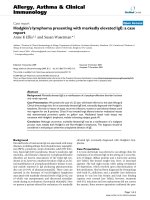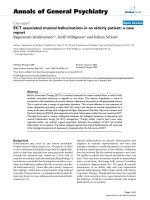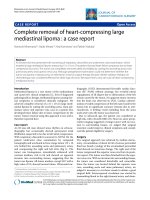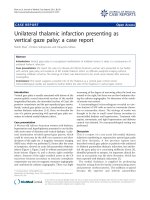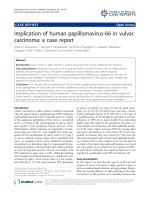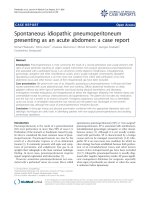Báo cáo y học: " Benign mesenteric lipodystrophy presenting as low abdominal pain: a case report" pptx
Bạn đang xem bản rút gọn của tài liệu. Xem và tải ngay bản đầy đủ của tài liệu tại đây (551.6 KB, 4 trang )
JOURNAL OF MEDICAL
CASE REPORTS
Rees and Burgess Journal of Medical Case Reports 2010, 4:119
/>Open Access
CASE REPORT
BioMed Central
© 2010 Rees and Burgess; licensee BioMed Central Ltd. This is an Open Access article distributed under the terms of the Creative Com-
mons Attribution License ( which permits unrestricted use, distribution, and reproduc-
tion in any medium, provided the original work is properly cited.
Case report
Benign mesenteric lipodystrophy presenting as
low abdominal pain: a case report
Jonathan Richard Rees
1
and Phillip Burgess*
2
Abstract
Introduction: Benign mesenteric lipodystrophy is rare and often presents in a non-specific fashion. Imaging findings
may mimic a range of malignant conditions, particularly malignant ovarian disease in women.
Case presentation: We present the case of a 61-year-old Caucasian woman who was referred to the gynaecology
service at our institution and was thought to have ovarian malignancy, and required a laparotomy. However,
histopathological analysis unexpectedly revealed benign mesenteric lipodystrophy.
Conclusion: Benign mesenteric lipodystrophy may mimic a range of conditions, particularly malignancy.
Introduction
Benign mesenteric lipodystrophy is a rare condition with
just over 200 cases being noted in the worldwide litera-
ture [1]. It was first described by Jura during the 1920s [2]
and is characterized by non-specific inflammation
involving the adipose tissue of the bowel mesentery [3]. It
is commonly asymptomatic, or only noted during cross
sectional imaging investigations that have been under-
taken for other indications [4]. However, some patients
present with symptoms that include abdominal tender-
ness or an abdominal mass while some may have abdomi-
nal pain, fever, a change in bowel habit and sometimes
weight loss [5,6].
Its etiology is unclear. However, previous trauma, mes-
enteric ischemia or infection have been suggested as
potential causes. Other documented possible associa-
tions with this disease include tuberculosis [1], pancreati-
tis, malignant tumour particularly lymphoma, vasculitis
and granulomatous diseases [7]. The histopathology of
this condition, which is also called sclerosing mesenteri-
tis, has been described in three phases. Initially, fat
necrosis is seen, leading to the nomenclature of mesen-
teric lipodystrophy. This is then followed by mesenteric
panniculitis, which is associated with profound inflam-
mation. Finally, fibrosis supervenes with mesenteric
retraction and shortening [4], hence the term 'sclerosing
mesenteritis'. In many cases, histopathology shows
changes consistent with all three histopathological phases
as these changes appear to occur at differing rates in dif-
ferent areas of the mesentery [5]. Patients with a treatable
cause, such as tuberculosis, have been described to have
almost complete resolution of the intra-abdominal
change when re-imaged [1] particularly in the mesenteric
lipodystrophy phase of the condition. We describe a case
mimicking ovarian malignancy.
Case presentation
A 61-year-old British Caucasian woman was initially
referred to the gynecology service in our institution with
low abdominal and pelvic pain. An initial clinical exami-
nation was unremarkable. However, a pelvic ultrasound
scan was undertaken and revealed cystic masses within
the pelvis. A potential diagnosis of ovarian malignancy
was considered and computed tomography (CT) was
then performed, which also suggested an intra-abdomi-
nal mass of possible ovarian origin (Figure 1). In view of
these findings, our patient underwent a laparotomy. At
this time, the ovaries were noted to be normal. However,
the mesentery of the small bowel was found to have mul-
tiple large mesenteric masses (Figure 2). These involved
the majority of the small bowel mesentery and were irre-
sectable. Biopsies were taken at this time and the mesen-
teric masses were shown to be benign with no evidence of
lymphoma or epithelial malignancy, but were diagnostic
for the mesenteric lipodystrophy stage if the illness. Our
* Correspondence:
2
Department of General Surgery, Great Western Hospital, Marlborough Road,
Swindon, SN3 6BB, UK
Full list of author information is available at the end of the article
Rees and Burgess Journal of Medical Case Reports 2010, 4:119
/>Page 2 of 4
patient had an uncomplicated post-operative course and
was discharged after five days.
A trial of tamoxifen 20 mg orally once daily was insti-
tuted in an attempt to reduce the size of the mesenteric
masses. However, follow up CT of the abdomen did not
shown any response after six months of therapy, so
tamoxifen was discontinued. A follow-up small bowel
study to exclude small bowel stricturing as a consequence
of mesenteric fibrosis has not revealed any abnormality.
Two years after the initial surgery, our patient remains
well.
Discussion
Benign mesenteric lipodystrophy is rare and has been
described in most detail in a three-case series by Durst
[6], Kipfer [7] and Emory [5] who together identify 165
patients. It is more common in men (2-3:1; M:F ratio),
and affects a large age range from 20 to 80 years but is
most common in individuals aged 50 to 60 years. It has a
broad range of clinical presentations with at least half of
those affected being asymptomatic. In these individuals,
it is a usually found at the time of cross-section imaging,
laparoscopy or laparotomy as in our case. The etiology of
this condition is unclear. However, associations have been
reported between mesenteric panniculitis and lymphoma
[7] while an autoimmune etiology or as a response to
ischaemia have also been postulated as possible causes
[8,9].
A range of symptoms are described, including most
commonly undiagnosed abdominal pain, and more com-
monly diagnosed signs of gastrointestinal obstruction.
Fever, weight loss, abdominal mass or even a protein-los-
ing enteropathy have been described. The frequency of
differing symptoms is unclear because of the rarity of the
condition but most reports suggest that the initial presen-
tation is either with abdominal pain or as an asymptom-
atic finding at cross-sectional imaging. Biochemical tests
are usually unhelpful, while hematological investigations
may only show anaemia or a raised erythrocyte sedimen-
tation rate (ESR) but are non-specific.
CT may help in making the diagnosis of mesenteric lip-
odystrophy. There are a number of features on CT that
may suggest mesenteric lipodystrophy. These include
increased attenuation in the small bowel described by Seo
et al. [10] as the 'misty mesentery' or in more advanced
cases there may be a solid soft tissue mass, which sur-
rounds the mesenteric vessels with preservation of the
surrounding fat around a "fat ring sign" on CT image
[11,12].
The CT findings are unfortunately not specific and can
mimic other lesions of the mesentery including lym-
phoma, lipoma, edema (of any etiology, for example heart
failure, vasculitis, cirrhosis or hypoalbuminemia), tuber-
Figure 1 Coronal computed tomography images showing multi-
ple solid and cystic intra-abdominal lesions marked with an ar-
row with associated calcification in the bowel wall.
Figure 2 Intra-operative photograph showing multiple small in-
testinal mesenteric masses. Suture line represents site of operative
sample of one of the multiple masses.
Rees and Burgess Journal of Medical Case Reports 2010, 4:119
/>Page 3 of 4
culosis, carcinomatosis or, very rarely, mesothelioma [10].
The extent of the change in the intra-abdominal fat may
be wide-ranging and can include the mesocolon, mesoap-
pendix, the peri-pancreatic region, the greater omentum
and pelvic fat, which may explain why the differential
diagnosis can be so extensive.
Diagnosis is usually during laparotomy, although it can
also be done during biopsy at the time of laparoscopy or
percutaneously [13,14]. Resectional surgery is of limited
value in this setting [6]. Although smaller lesions may be
resected for diagnostic purposes, the diffuse involvement
of the mesentery would mean that excessively long seg-
ments of small bowel would have to be removed to clear
the bulk of the mesenteric change resulting in significant
morbidity.
Histologically, the condition shows a progressive series
of changes. However, the different histological stages
often co-exist within the same specimen. Initially, the
mesentry is infiltrated with lipid-filled macrophages
within the fat-filled septa of the mesenteric adipose tis-
sue, which is known as mesenteric lipodystrophy. As the
condition progresses and inflammation supervenes, lym-
phocytes infiltrate the mesentery and lipid cystic necrosis
can be identified. This is a change known as mesenteric
panniculitis. Later, necrosis with associated fibrosis dom-
inates. This is associated with shortening of the mesen-
tery, and is called the retractile mesenteritis stage.
Typically, these changes may be identified by H&E stain-
ing. However, in cases where there is diagnostic difficulty
particularly, when differentiating mesenteric lipodystro-
phy from gastrointestinal stromal tumours.(GISTs) and
mesenteric fibromatosis, Montgomery et al. suggest that
immunohistochemistry using a panel of antibodies
(CD117, beta-catenin, CD34, smooth muscle actin,
desmin, keratin, and S-100 protein) may help differenti-
ate the histological types [15].
Treatment of this condition depends on the stage of the
disease: early changes are nearly always managed conser-
vatively as the illness resolves in many individuals with
the lipodystrophy phase without intervention. In the later
panniculitis or fibrotic phases of the illness, a range of
treatments have been investigated. To suppress inflam-
mation, steroids, cyclophosphamide [8], azathioprine and
colchicine, treatment successes have also been reported
after the use of tamoxifen and oral progesterones [16].
However, if fibrosis occurs that leads to symptomatic
strictures of the gastrointestinal tract, then surgical resec-
tion of the affected segment is indicated [17,18].
Conclusion
Mesenteric lipodystrophy is a rare condition that can
mimic a number of intra-abdominal conditions including
ovarian pathology. It can be difficult to diagnose and is
often only fully apparent at the time of laparoscopy or
laparotomy. Histologically, it forms part of a continuum
of inflammation and fibrosis and may often in the early
stages resolve spontaneously. Although often unneces-
sary in the early stages, treatment may require immuno-
suppression or even resectional surgery in the later stages
if the disease progresses.
Consent
Written informed consent was obtained from our patient
for publication of this case report and accompanying
images. A copy of the written consent is available for
review by the journal's Editor-in-Chief.
Abbreviations
CT: computerised tomography; ESR: erythrocyte sedimentation rate; H&E: Hae-
matoxylin and Eosin; GISTs: Gastrointestinal stromal tumours.
Competing interests
The authors declare that they have no competing interests.
Authors' contributions
JR and PB were involved in the direct clinical care of our patient and therapeu-
tic planning and both authors contributed equally to the manuscript. Both
authors read and approved the final manuscript
Author Details
1
Department of General Surgery, Gloucestershire Royal Hospital, Great Western
Road, Gloucester, GL1 3NN UK and
2
Department of General Surgery, Great
Western Hospital, Marlborough Road, Swindon, SN3 6BB, UK
References
1. Ege G, Akman H, Cakiroglu G: Mesenteric panniculitis associated with
abdominal tuberculous lymphadenitis: a case report and review of the
literature. Br J Radiol 2002, 75(892):378-380.
2. Jura V: Mesenterite retrattile-caso clinico: risultati sperimentali, rilievi
patogenetici, considerazoni cliniche. Policlinico 1927, 34:535-556.
3. Daskalogiannaki M, Voloudaki A, Prassopoulos P, Magkanas E, Stefanaki K,
Apostolaki E, Gourtsoyiannis N: CT evaluation of mesenteric panniculitis:
prevalence and associated diseases. AJR Am J Roentgenol 2000,
174(2):427-431.
4. Vettoretto N, Diana DR, Poiatti R, Matteucci A, Chioda C, Giovanetti M:
Occasional finding of mesenteric lipodystrophy during laparoscopy: a
difficult diagnosis. World J Gastroenterol 2007, 13(40):5394-5396.
5. Emory TS, Monihan JM, Carr NJ, Sobin LH: Sclerosing mesenteritis,
mesenteric panniculitis and mesenteric lipodystrophy: a single entity?
Am J Surg Pathol 1997, 21(4):392-398.
6. Durst AL, Freund H, Rosenmann E, Birnbaum D: Mesenteric panniculitis:
review of the leterature and presentation of cases. Surgery 1977,
81(2):203-211.
7. Kipfer RE, Moertel CG, Dahlin DC: Mesenteric lipodystrophy. Ann Intern
Med 1974, 80(5):582-588.
8. Bush RW, Hammar SP Jr, Rudolph RH: Sclerosing mesenteritis. Response
to cyclophosphamide. Arch Intern Med 1986, 146(3):503-505.
9. Hartz RSS, Sparberg M, Poticha SM: Mesenteric tumefaction. American
Surgeon 1980, 46:525-529.
10. Seo BK, Ha HK, Kim AY, Kim TK, Kim MJ, Byun JH, Kim PN, Lee MG, Yang SK,
Yu ES, Kim JH: Segmental misty mesentery: analysis of CT features and
primary causes. Radiology 2003, 226(1):86-94.
11. Horton KM, Lawler LP, Fishman EK: CT findings in sclerosing mesenteritis
(panniculitis): spectrum of disease
. Radiographics 2003,
23(6):1561-1567.
12. Patel N, Saleeb SF, Teplick SK: General case of the day. Mesenteric
panniculitis with extensive inflammatory involvement of the
peritoneum and intraperitoneal structures. Radiographics 1999,
19(4):1083-1085.
Received: 4 November 2009 Accepted: 27 April 2010
Published: 27 April 2010
This article is available from: 2010 Rees and Burgess; licensee BioMed Central Ltd. This is an Open Access article distributed under the terms of the Creative Commons Attribution License ( which permits unrestricted use, distribution, and reproduction in any medium, provided the original work is properly cited.Journal of Medical Case Repo rts 2010, 4:119
Rees and Burgess Journal of Medical Case Reports 2010, 4:119
/>Page 4 of 4
13. Weiser J, Salky B, Slepian A, Dikman S: Laparoscopic diagnosis of
retractile mesenteritis. Gastrointest Endosc 1992, 38(5):615-617.
14. Rajendran B, Duerksen DR: Retractile mesenteritis presenting as protein-
losing gastroenteropathy. Can J Gastroenterol 2006, 20(12):787-789.
15. Montgomery E, Torbenson MS, Kaushal M, Fisher C, Abraham SC: Beta-
catenin immunohistochemistry separates mesenteric fibromatosis
from gastrointestinal stromal tumor and sclerosing mesenteritis. Am J
Surg Pathol 2002, 26(10):1296-1301.
16. Colomer Rubio E, Blanes Gallego A, Carbonell Biot C, Villar Grimalt A,
Tomas Ivorra H, Llamusi Lorente A: Mesenteric panniculitis with
retroperitoneal involvement resolved after treatment with intravenous
cyclophosphamide pulses. An Med Interna 2003, 20(1):31-33.
17. Parra-Davila E, McKenney MG, Sleeman D, Hartmann R, Rao RK, McKenney
K, Compton RP: Mesenteric panniculitis: case report and literature
review. Am Surg 1998, 64(8):768-771.
18. Shah D, Patel S, Shah S, Goswami K: Mesenteric panniculitis a case report
and review of the literature. Indian J Radiol Imag 2005, 64:768-771.
doi: 10.1186/1752-1947-4-119
Cite this article as: Rees and Burgess, Benign mesenteric lipodystrophy pre-
senting as low abdominal pain: a case report Journal of Medical Case Reports
2010, 4:119
